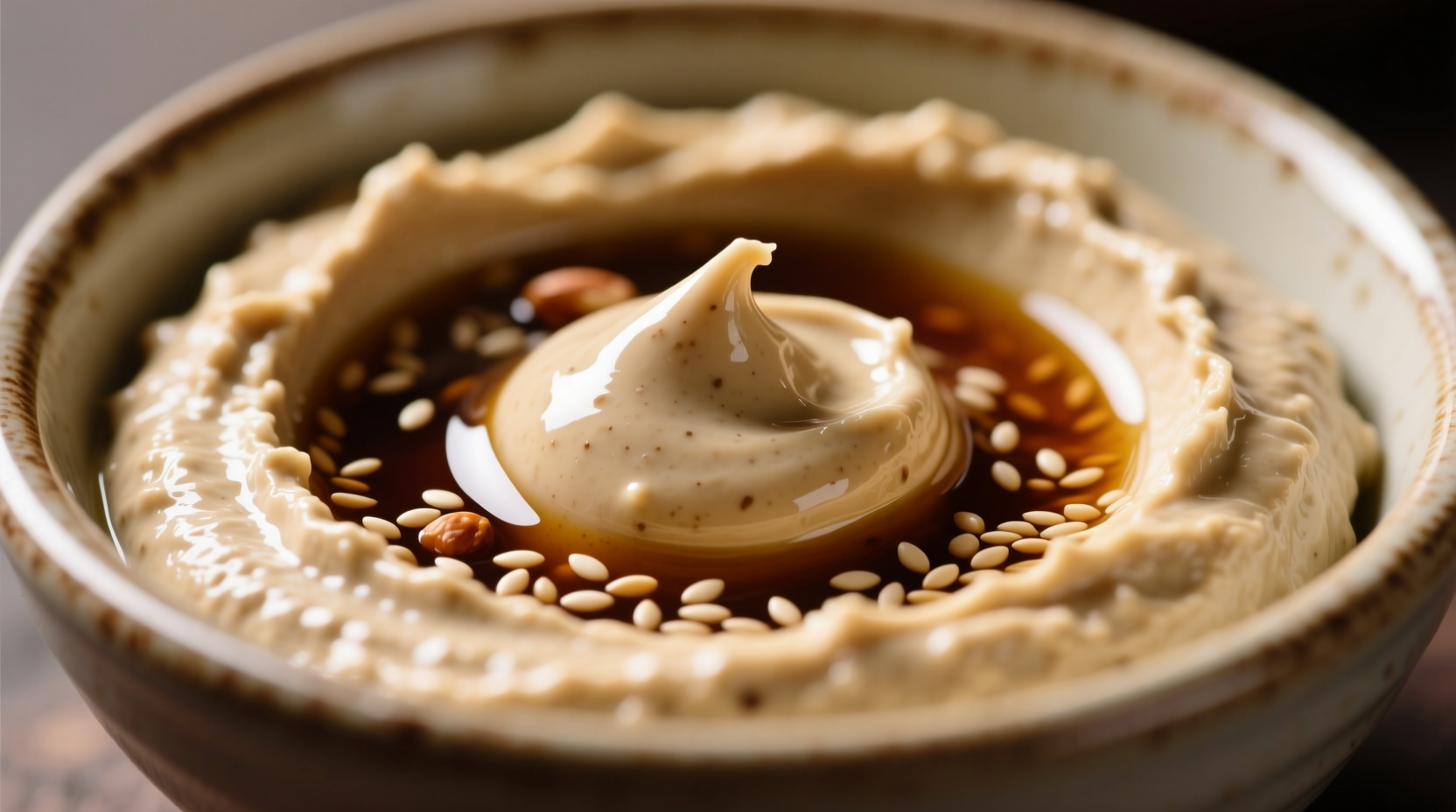Understanding Tahini's Distinctive Flavor Profile
When you first taste tahini, you'll notice its dominant nutty character—similar to peanut butter but with a more complex, earthy undertone. Unlike sweet nut butters, tahini delivers a savory experience with a subtle roasted sesame seed flavor that forms the backbone of Middle Eastern cuisine. The best tahini offers a smooth, rich mouthfeel with a delicate balance between nuttiness and a barely perceptible natural sweetness, finishing with a mild, pleasant bitterness that shouldn't overwhelm.
What many first-time tasters don't expect is tahini's remarkable versatility. This sesame paste transforms dramatically when mixed with other ingredients—lemon juice brightens its earthiness, garlic adds pungency, and salt enhances its natural nuttiness. Understanding what tahini tastes like helps you harness its full potential in both traditional and innovative recipes.
Breaking Down Tahini's Taste Components
Tahini's flavor profile consists of several distinct elements that work together to create its signature taste:
- Nutty foundation - The primary flavor reminiscent of toasted sesame seeds
- Earthy undertones - A deep, soil-like quality that adds complexity
- Subtle bitterness - Particularly noticeable in higher quality tahini with unhulled seeds
- Creamy texture - Smooth and spreadable when properly made
- Hint of natural sweetness - Not added sugar, but the inherent quality of well-roasted sesame
- Light roasted notes - From the toasting process that develops flavor
Unlike peanut or almond butter, tahini contains no added sugars or stabilizers in its traditional form. This purity means you're tasting the unadulterated essence of sesame seeds, which explains why how tahini tastes different from other nut butters is such a common question among curious cooks.
How Quality Affects Tahini's Flavor
Not all tahini tastes the same—several factors dramatically impact its flavor profile:
| Quality Factor | High-Quality Tahini | Lower-Quality Tahini |
|---|---|---|
| Sesame Seed Type | Single-origin hulled or unhulled seeds with consistent roast | Mixed origins, inconsistent roasting |
| Texture | Smooth, pourable, homogeneous | Grainy, separated, or chalky |
| Flavor Balance | Harmonious nuttiness with subtle bitterness | Overpowering bitterness or blandness |
| Aftertaste | Clean, lingering nuttiness | Bitter or metallic finish |
The difference between premium and inferior tahini becomes especially apparent when tasting it straight from the jar. High-quality tahini should never taste rancid or overly bitter—it should have a fresh, roasted sesame aroma and a flavor that invites you to take another spoonful.
Tahini vs. Similar Products: A Flavor Comparison
Understanding what tahini tastes like compared to other nut and seed butters helps contextualize its unique profile:
- Peanut butter - Sweeter, more pronounced nut flavor, often with added sugar and oil
- Almond butter - Milder, slightly sweeter with less earthiness
- Sunflower seed butter - More bitter and less complex than tahini
- Hummus - Tahini's flavor is present but blended with chickpeas, lemon, and garlic
- Sesame oil - More concentrated sesame flavor but completely different texture
Food science research from the US Department of Agriculture confirms that sesame seeds contain unique compounds like sesamol and sesamin that create tahini's distinctive flavor profile, setting it apart from other seed and nut butters. These compounds develop during the roasting process and contribute to tahini's characteristic nuttiness and subtle bitterness.
How Preparation Changes Tahini's Taste Experience
What many people don't realize is that tahini's flavor transforms dramatically when prepared properly. The traditional Middle Eastern technique of "whisking tahini with water" before use isn't just for texture—it fundamentally changes the flavor chemistry:
- Dry tahini - Can taste overly bitter and one-dimensional
- Add lemon juice - Brightens flavors and reduces bitterness
- Whisk in cold water - Creates emulsion that smooths harsh notes
- Add garlic - Introduces pungent complexity that complements sesame
- Final texture - Should be creamy, pourable, and balanced
This preparation method, documented in culinary research from Harvard University's Food Science Department, activates enzymatic reactions that mellow tahini's natural bitterness while enhancing its nutty complexity. Understanding this transformation explains why many people who tried tahini straight from the jar disliked it, only to fall in love with it when properly prepared.

Perfect Pairings: What Complements Tahini's Flavor
Tahini's unique taste profile shines when paired with complementary ingredients. Knowing what tahini tastes good with unlocks its full culinary potential:
- Acidic elements - Lemon juice or vinegar balances richness and reduces bitterness
- Garlic - Adds pungency that complements tahini's earthiness
- Roasted vegetables - Especially eggplant, cauliflower, and sweet potatoes
- Spices - Cumin, coriander, and smoked paprika enhance its depth
- Sweet elements - Honey or maple syrup creates delicious sweet-savory combinations
- Herbs - Fresh parsley, cilantro, or dill add brightness
Culinary experts at the Culinary Institute of America note that tahini's flavor works particularly well with ingredients that have their own earthy or roasted qualities. This explains why it's the perfect complement to roasted vegetables, grilled meats, and hearty grains.
Common Misconceptions About Tahini's Taste
Several myths persist about tahini's flavor that prevent people from fully appreciating it:
- "Tahini tastes like peanut butter" - While both are nut/seed butters, tahini is significantly less sweet with more earthiness
- "All tahini is bitter" - Quality tahini has only a subtle bitterness that balances the nuttiness
- "Tahini should be thick like peanut butter" - Properly made tahini is naturally pourable
- "You shouldn't taste sesame in tahini" - Sesame flavor is the essence of tahini
- "Tahini tastes bad straight from the jar" - High-quality tahini is enjoyable on its own
These misconceptions often stem from experiences with lower quality tahini products or improper preparation techniques. When made well and prepared correctly, tahini offers a sophisticated flavor experience that has been appreciated across Mediterranean and Middle Eastern cultures for centuries.
How to Select the Best-Tasting Tahini
When shopping for tahini, use these guidelines to find the best flavor:
- Look for products with just one ingredient: sesame seeds
- Avoid brands with added oils, sugars, or preservatives
- Check the color—ivory to light brown indicates proper roasting
- Smell the jar—should have a fresh, roasted aroma without mustiness
- Consider origin—Lebanese and Israeli brands often set the quality standard
- Check separation—some oil separation is normal, but should remix easily
Food safety experts at the U.S. Food and Drug Administration recommend storing tahini in the refrigerator after opening to maintain freshness and prevent rancidity, which directly impacts flavor quality. Properly stored tahini can maintain its optimal taste for 3-6 months.
Putting Tahini's Flavor to Work in Your Kitchen
Now that you understand what tahini tastes like and how to work with it, here are practical ways to incorporate it into your cooking:
- Salad dressings - Whisk with lemon juice, garlic, and water for a creamy dressing
- Marinades - Combines beautifully with yogurt for tenderizing meats
- Sauces - The base for authentic hummus, baba ghanoush, and tarator
- Baking - Adds moisture and nuttiness to cookies and cakes
- Breakfast - Drizzle over oatmeal or toast with honey
- Dips - Mix with roasted red peppers or herbs for quick appetizers
Professional chefs consistently emphasize that tahini's flavor works best when it's not the sole ingredient but part of a balanced flavor profile. Start with small amounts and adjust to taste—its potent flavor can easily dominate a dish if overused.
Frequently Asked Questions
Does tahini taste bitter?
High-quality tahini has only a subtle, pleasant bitterness that balances its nuttiness. Overly bitter tahini usually indicates poor quality, improper roasting, or rancidity. The bitterness should never be overwhelming—think of it as the dark chocolate to peanut butter's milk chocolate.
Is tahini supposed to taste like peanut butter?
No, tahini has a distinctly different flavor profile than peanut butter. While both are nut/seed butters, tahini is less sweet with more earthy, roasted notes and subtle bitterness. Peanut butter has a stronger, sweeter nut flavor, while tahini offers a more complex, savory experience that works well in both sweet and savory applications.
Why does my tahini taste bad?
Tahini that tastes unpleasant is usually either low quality, improperly stored (leading to rancidity), or being tasted incorrectly. Always whisk tahini with lemon juice and cold water before tasting—it transforms the flavor dramatically. If it still tastes bitter or off, it may be expired or made from poorly roasted seeds.
Does tahini taste better when mixed with other ingredients?
Yes, tahini's flavor shines when properly incorporated into recipes. The traditional method of whisking with lemon juice and cold water creates an emulsion that balances its natural bitterness while enhancing its nuttiness. When combined with complementary ingredients like garlic, spices, or roasted vegetables, tahini becomes a complex flavor enhancer rather than a standalone ingredient.
How can you tell if tahini has gone bad?
Spoiled tahini develops a noticeably sharp, rancid odor and may taste overly bitter or sour. The color might darken significantly, and the texture could become excessively hard or develop mold. Fresh tahini should have a pleasant roasted sesame aroma and smooth texture. When in doubt, discard it—rancid tahini won't improve the flavor of your dishes.











 浙公网安备
33010002000092号
浙公网安备
33010002000092号 浙B2-20120091-4
浙B2-20120091-4